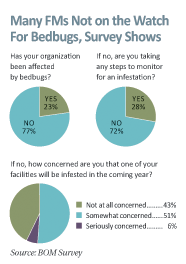Biggest Concern With Bed Bugs is Psychological, not Physical
Bed bugs are not known to be a classical carrier of human pathogens and cause disease, says Potter, though it has been known for better than 40 years that there are any number of pathogens that can be found on bed bugs, including MRSA.
"The question is, can they infect people through the bite," Potter says. "It seems this is unlikely with bed bugs, as a lot of these pathogens don't seem to be able to multiply in the bed bug's body."
Certain people have an allergic reaction to bed bug bites, and if someone were to scratch a bite, breaking their skin and creating a path of entry for pathogens that might have been on a bed bug's body, they could possibly end up with an infection, Potter says. "We're a long way from saying bed bugs are causing infections, but it certainly does add to the concern," he says.
In the general population, the main concern is that humans are the meal, and that the predation happens while we sleep in our beds, violating a sense of personal space and ability to control the situation in a way that mosquitoes, for example, do not. This has fueled a healthy trade in all manner of products claiming to kill bed bugs.
"Steam and heat are the most effective non-pesticide tools," says Jody Gangloff Kaufman, urban entomologist with Cornell University. Of the pesticides that are available to effectively deal with bed bugs, none are available over the counter.
"Ant and wasp sprays, insect foggers — these do not work," says Changlu Wang, assistant professor in the department of entomology at Rutgers University. "There are no data showing they have a significant effect on bed bugs. Don't just buy over the counter. Professionals have professional products they can use."
Sensitivities of a facility's population will influence which bed bug treatment options are pursued. When a few bed bugs were found in an elementary school in the Anchorage School District, the administration wanted to deal with the issue decisively, says Darin Hargraves, director of operations.
"We didn't want these things going from our schools back to people's homes," Hargraves says. "We wanted it to stop with us."
Because the infestation coincided with a three-day holiday weekend, the district, covering 8 million square feet and serving 50,000 students, didn't have time to give the parental notice required to use a pesticide solution. So over the course of two days, when the outside temperature was 10 F, their pest control contractor brought different rooms in the affected wing of the school up to 135 F for over an hour.
"The reality is that bed bugs came to our school through our population that uses the facility," says Hargraves. "No sooner do you get it cleaned out, it's very possible that the next person coming in can bring one." Though 69 percent of affected survey respondents report a one-time infestation, 31 percent have had an average of three infestations about four months apart.
But dealing with children, and as a public entity, the school district never considered making affected children stay home. They have, however, instituted some protocols to address the situation. Students might go to the nurse's office to have their clothing and personal items heat-treated; the school has a clothes dryer and a heat treatment box. "But we do this with the permission of the parents and as discreetly as possible," Hargraves says.

Click to download PDF
Related Topics:














